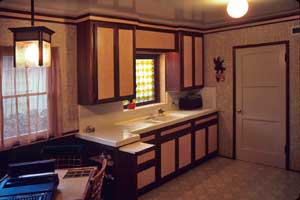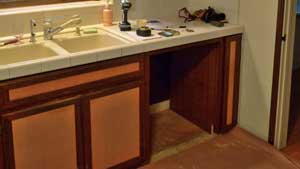
I had reason to go to Los Angeles recently to prepare my parents’ old house for rental, which included modifying the cabinets in the kitchen to accept a new appliance.
First, a little backstory: I made some very fancy kitchen cabinets for my folks’ kitchen back in the days when I built custom cabinets and furniture for a living. The carcasses and face frames were all Honduran mahogany stained dark, to look like rosewood— something that was not uncommon in early American period furniture. The panels for the doors and drawer fronts were made from some absolutely gorgeous bird’s-eye maple I’d had in my wood stash. The dark and light contrast was unusual, but my mom loved it, so I continued the theme throughout the kitchen, using the same wood combination for a heavy crown molding that capped the cabinets and ran around the whole kitchen as well as wainscoting and a chair rail that lined the room’s breakfast nook. I also added a long pull-out cutting board made from laminated rock maple and a built-in wine rack to the peninsula cabinet that defined one end of the breakfast nook. Since this project was a labor of love (OK, and maybe as a bit of payback for all the times my folks bailed me out), I finished the cabinets inside and out, so they gleamed with the pride of creation.
But now, nearly 30 years later, my realtor pointed out a significant feature that this custom kitchen was missing: a dishwasher. My saintly mother had refused to even consider one. “What’s the use of having a machine to wash dishes when you have to rinse food off of them before, and wipe off the water spots afterwards?” But try explaining that to a tenant with three small children and dishes that pile up faster than cash in the middle of a table at a high-stakes poker game.
So my job was to modify the existing lower sink cabinet (with a shallow drawer over a shelved compartment covered by a pair of doors) to accept a dishwasher. This would have been easy enough, but my folks’ house is more than 350 miles from where I live. I had to figure out how I was going to do the job without the advantage of being able to actually examine the cabinets. And since I drove down to LA in a small convertible, I really stressed over which tools I would need to take. I ended up packing my car as tightly with tools as meat in a food freezer at the end of a successful deer season. I brought tools to meet every conceivable contingency: “What if I used screws or nails in the face frames? I’ll need a recip saw and a bi-metal blade. What if I need to rework some of the existing cabinet parts? I’ll need a router and bits, and sandpaper, and stain, and, and….”
When I finally got down there, I was pleasantly surprised to discover that my memory of the cabinet construction turned out to be relatively accurate. Better still, I was lucky: The spacing was just right and I could remove the existing drawer and lower doors, add a plywood bulkhead to create the necessary dishwasher opening, and have a narrow end compartment left that could house large trays and flat pans.I used one of the face frame rails to create a stile to cover the edge of the new ply bulkhead, then added hinges to the frame-and-panel front I took off the existing drawer and used it as a tall vertical door to cover the new tray compartment — it was the perfect length to do the job! When all the woodwork was done and the new dishwasher slipped into place and hooked up (thanks to more-than-a-little help from a plumber and an electrician), I think even my mother would have approved.
Sandor Nagyszalanczy
Contributing Editor






